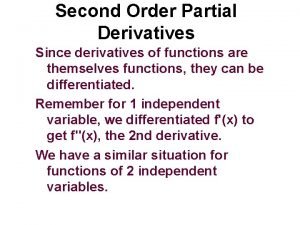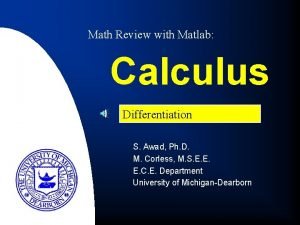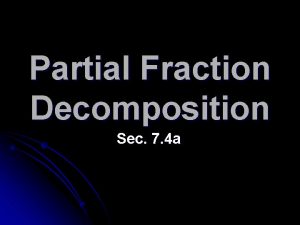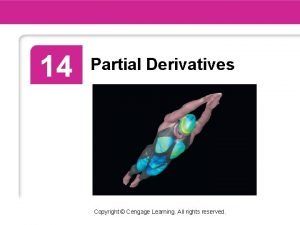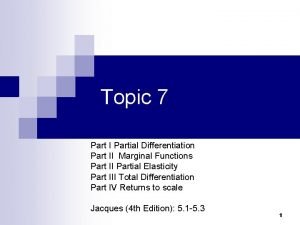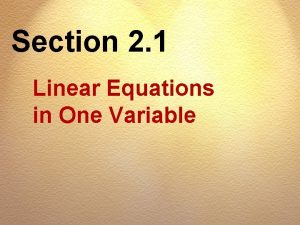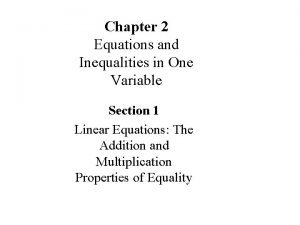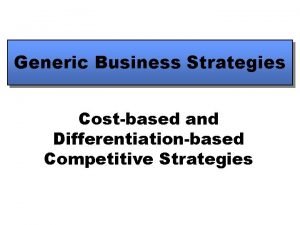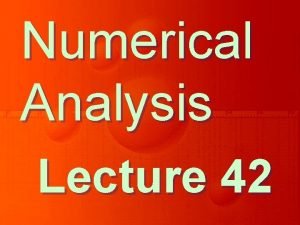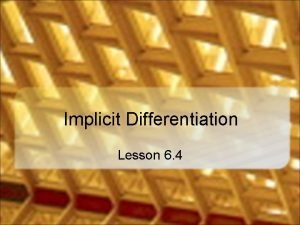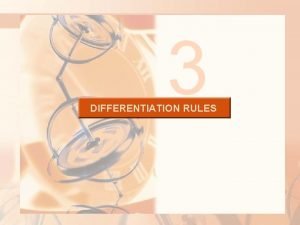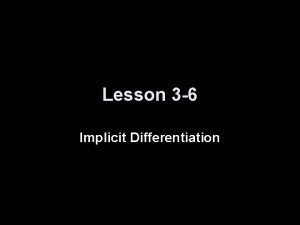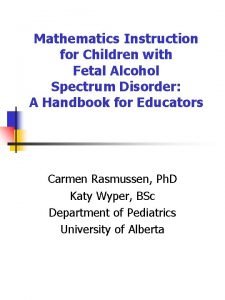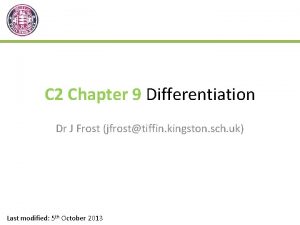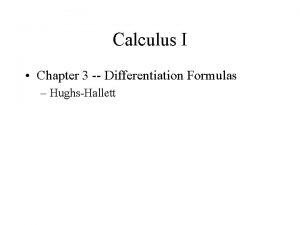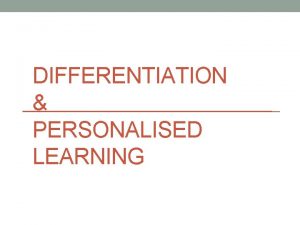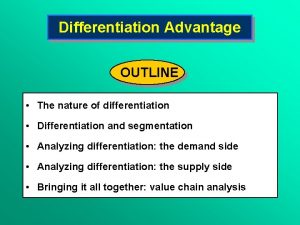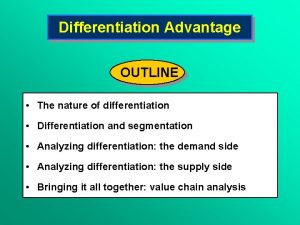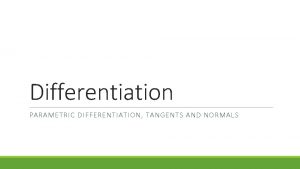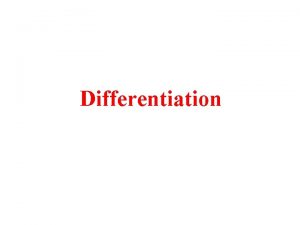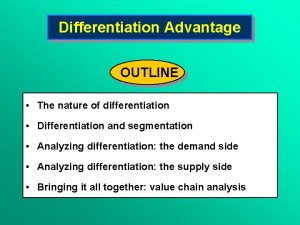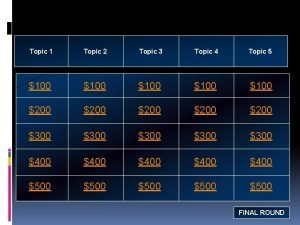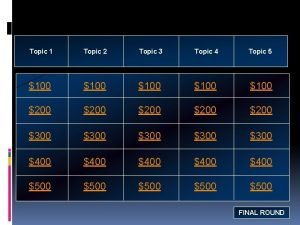Topic 7 Part I Partial Differentiation Part II



























- Slides: 27

Topic 7 Part I Partial Differentiation Part II Marginal Functions Part II Partial Elasticity Part III Total Differentiation Part IV Returns to scale Jacques (4 th Edition): 5. 1 -5. 3 1

Functions of Several Variables n More realistic in economics to assume an economic variable is a function of a number of different factors: Y =f(X, Z) n Demand may depend on the price of the good and the income level of the consumer Qd =f(P, Y) n Output of a firm depends on inputs into the production process like capital and labour Q =f(K, L) 2

Graphically Sketching functions of two variables Y= f (X, Z) n Sketch this function in 3 -dimensional space n or n plot relationship between 2 variables for constant values of the third n 3

For example I n Consider a linear function form: y =a+bx+cz n For different values of z we can represent the relationship between x and y 4

For example II Consider a non-linear function form: Y=X Z 0< < 1 & 0< < 1 n For different values of z we can represent the relationship between x and y n 5

Part I: Partial Differentiation (Differentiating functions of several variables) 6

Consider our function of two variables: Y= f (x, z) = a + bx + cz 7

FOUR Second Order Partial Derivatives 8

Consider our function of two variables: Y= f (X, Z) = X Z First Partial Derivatives Y/ X = f. X = X -1 Z >0 Y/ Z = f. Z = X Z -1 > 0 9

Since Y/ X = f. X = X -1 Z Y/ Z = f. Z = X Z -1 Second own partial 2 Y/ X 2 = f. XX = ( -1) X -2 Z 2 Y/ Z 2 = f. ZZ = ( -1) X Z -2 < 0 Second cross partial 2 Y/ X Z = f. XZ = X -1 Z -1 2 Y/ Z X = f. ZX = X -1 Z -1 > 0 10

Example Jacques Y= f (X, Z) = X 2 +Z 3 f. X = 2 X > 0 Positive relation between x and y f. XX = 2 > 0 but at an increasing rate with x f. XZ = 0, (= fzx) and a constant rate with z impact of change in x on y is bigger at bigger values of x but the same for all values of z f. Z = 3 Z 2 > 0 Positive relation between z and y f. ZZ = 6 Z > 0 but at an increasing rate with z f. ZX = 0 (= fxz) and a constant rate with x impact of change in z on y is bigger at bigger values of z, but the same for all values of x 11

Example Jacques Y= f (X, Z) = X 2 Z f. X = 2 XZ >0 Positive relation between x and y f. XX = 2 Z >0 but at an increasing rate with x f. XZ = 2 X >0 and at an increasing rate with z impact of change in x on y is bigger at bigger values of x and bigger values of z f. Z = X 2 f. ZZ = 0 f. ZX = 2 X >0 Positive relation between z and y but at a constant rate with z >0 and an increasing rate with x impact of change in z on y is the same for all values of z but is bigger 12 at higher values of x

Production function example Y= f(K L) = K 1/3 L 2/3 First partial derivatives of input gives Marginal product of input MPL= Y/ L=YL= ( 2/3 K 1/3 L 2/3 -1) = 2/3 Y/L >0 n An increase in L holding other inputs constant will increase output Y MPK= Y/ K = YK=( 1/3 K 1/3 -1 L 2/3) = 1/3 Y/K > 0 An increase in K holding other inputs constant will increase output Y 13

MPL = Y/ L = ( 2/3 K 1/3 L -1/3) = 2/3 Y/L. MPK = Y/ K = ( 1/3 K-2/3 L 2/3) = 1/3 Y/K. n Second Own derivatives of input gives Marginal Returns of input (or the change in the marginal product of an input with the level of that input) 2 Y/ L 2 = -2/9 K 1/3 L -4/3 < 0 Diminishing marginal returns to L (the change in MPL with L shows that the MPL decreases at higher values of L) 2 Y/ L 2 = -2/9 K-5/3 L 2/3 < 0 Diminishing marginal returns to K (the change in the MPK with K shows that the MPK decreases at higher values of K) 14

Part II: Partial Elasticity 15

e. g. Y= f(K L) = K 1/3 L 2/3 16

P = 10, PS = 12, Y= 1000 Q=192 e. g. demand function Q = f( P, PS, Y) Partial Own-Price Elasticity of Demand QP = Q/ P. P/Q = -2 * (10/192) = - 0. 10 Partial Cross-Price Elasticity of Demand QPS = Q/ PS. PS/Q = +1 * (12/192) = 0. 06 Partial Income Elasticity of Demand QI = Q/ Y. Y/Q = +0. 1 * (1000/192) = 0. 52 17

Part III: Total Differential: Y= f (X) Y= d. Y/d. X. X If X =10 and d. Y/d. X = 2, Y = 2. 10 = 20 Total Differential: Y= f (X, Z) Y= Y/ X. X + Y/ Z. Z or d. Y= Y/ X. d. X + Y/ Z. d. Z 18

Example: Y= f (K, L) = Y = K 1/3 L 2/3 d. Y= Y/ K. d. K + Y/ L. d. L or d. Y= (1/3 K-2/3 L 2/3). d. K + (2/3 K 1/3 L-1/3). d. L Rewriting: d. Y= (1/3 K 1/3 K-1 L 2/3). d. K + (2/3 K 1/3 L 2/3 L-1). d. L or d. Y= 1/3. Y/K. d. K + 2/3. Y/L. d. L To find proportionate change in Y d. Y/ = 1/. d. K/ + 2/. d. L/ Y 3 K 3 L 19

Total Differential: Y= f (X, Z) Y= A f (K, L) = Y = A K L d. Y= Y/ K. d. K + Y/ L. d. L + Y/ A. d. A or d. Y= . AK -1 L d. K + . AK L -1. d. L + K L. d. A d. Y= . Y/K. d. K + . Y/L. d. L + Y/A. d. A Or for proportionate change in Y: d. Y/Y= . d. K/K + . d. L/L + d. A/A Or for proportionate change in A: d. A/A = d. Y/Y–(. d. K/K+. d. L/L) 20

Part IV: Returns to Scale Returns to scale shows the change in Y due to a proportionate change in ALL factors of production. So if Y= f(K, L) Constant Returns to Scale f( K, L ) = f(K, L) = Y Increasing Returns to Scale f( K, L ) > f(K, L) > Y Decreasing Returns to Scale f( K, L ) < f(K, L) < Y 21

Cobb-Douglas Production Function: Y = AK L Quick way to check returns to scale in Cobb. Douglas production function Y = AK L then if + = 1 : CRS if + > 1 : IRS if + < 1 : DRS 22

Example: Y= f(K, L) = A K L Y*= f( K, L) = A ( K) ( L) Y*= A K L = + AK L = + Y + = 1 Constant Returns to Scale + > 1 Increasing Returns to Scale + < 1 Decreasing Returns to Scale 23

Homogeneous of Degree r if: n f( X, Z ) = r f(X, Z) = r Y n Homogenous function if by scaling all variables by , can write Y in terms of r n Note superscripts! n Note then, for cobb-douglas Y = K L , the function is homogenous of degree + 24

Eulers Theorem X f. X + Z f. Z = r f(X, Z) = r. Y E. g. r =1, Constant Returns to Scale If Y= f(K, L) = A K L(1 - ) Does K f. K + L f. L = r. Y = Y ? K ( Y/K) + L((1 - )Y/L) = ? Y + (1 - )Y = Y + Y - Y = Y Thus, Eulers theorem shows (MPk * K ) + (MPL * L) = Y in the case of homogenous production functions of degree 1 25

Example. . If Y = K½ L½ then Y( K, L) = ( K)½ ( L)½ = ½K½ ½L½ = 1 K½ L½ = Y homogenous degree 1. . . constant returns to scale Eulers Theorem: show that K. Y/ K + L. Y/ L = r. Y = Y (r=1 as homog. degree 1) = K. (½. K½ -1. L½) + L. (½. K½. L½ -1) = K(½. Y/K) + L(½. Y/L) = ½. Y + ½. Y = Y 26

Summary: Function of Two Variables Partial Differentiation Production Functions– first derivatives (marginal product of K or L) and second derivatives (returns to K or L) n Partial Elasticity – Demand with respect to own price, price of another good, or income n Total Differentials n Returns to Scale Plenty of Self-Assessment Problems and Tutorial Questions on these things…. n 27
 Second order partial derivative
Second order partial derivative Partial differentiation
Partial differentiation Contoh soal turunan fungsi vektor
Contoh soal turunan fungsi vektor Derivative matlab
Derivative matlab Partial derivative interpretation
Partial derivative interpretation How to solve partial fraction
How to solve partial fraction Implicit partial differentiation
Implicit partial differentiation Elasticity partial derivative
Elasticity partial derivative Example of a clincher sentence
Example of a clincher sentence Research problem example for students
Research problem example for students Rstuv
Rstuv Section 2 topic 1 linear equations in one variable part 1
Section 2 topic 1 linear equations in one variable part 1 1.topic/title
1.topic/title Topic sentence has two parts
Topic sentence has two parts A differentiation-based competitive advantage
A differentiation-based competitive advantage Conclusion differentiation
Conclusion differentiation Richardson's extrapolation
Richardson's extrapolation Numerical differentiation examples
Numerical differentiation examples What is product differentiation
What is product differentiation Implicit differentiation
Implicit differentiation Differentiation definition
Differentiation definition Differentiation in r
Differentiation in r Hyperbolic differentiation formulas
Hyperbolic differentiation formulas Derivative of sec^2x
Derivative of sec^2x Difference between service and product
Difference between service and product Carpet patch differentiation
Carpet patch differentiation First frost chapter 9
First frost chapter 9 Differential calculus formulas
Differential calculus formulas
